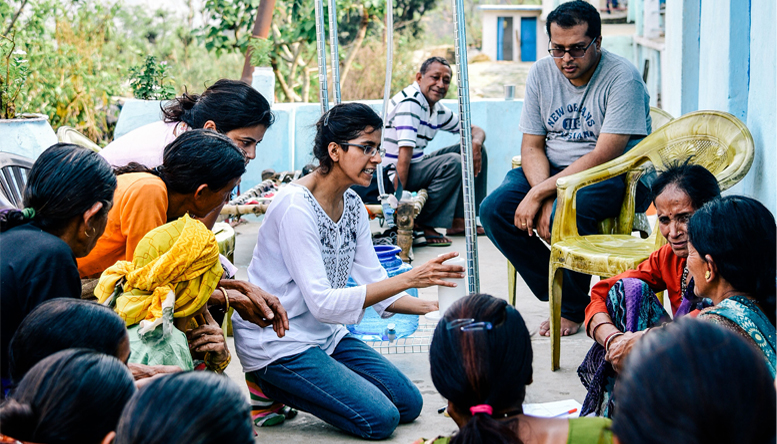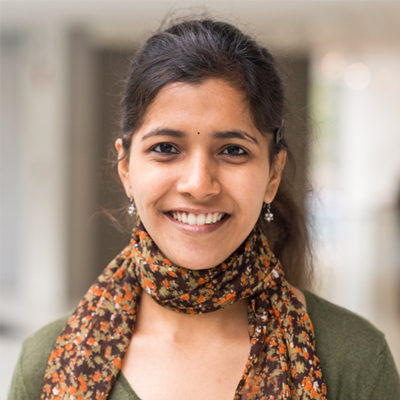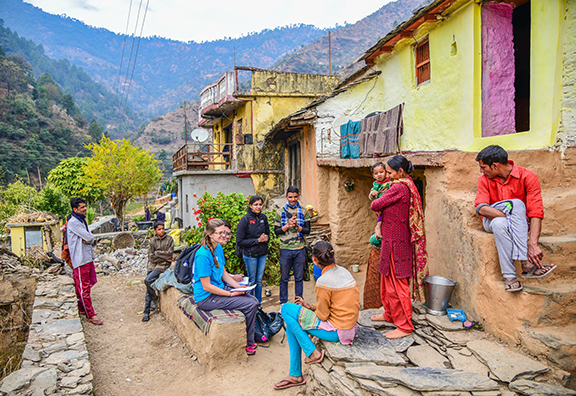News Student Spotlight: Engineering Low-cost Filters for Clean Water Access
Andi Sutton, Communications and Program Manager J-WAFS March 6, 2019

Credit: Megha Hegde, D-Lab
About five years ago, Professor Rohit Karnik in the Department of Mechanical Engineering first demonstrated the ability of the xylem tissue of coniferous trees to filter bacterial contaminants out of water (article link). When PhD student Krithika Ramchander began her graduate studies in his lab in 2015, Professor Karnik presented this challenge: make a filter using the xylem material that can function effectively in real-world, household settings.
Krithika, a 2018-2019 J-WAFS fellow, launched into a research trajectory with Professor Karnik that has since grown into a collaborative endeavor with MIT D-Lab and other NGOs across India. Supported by funding from the MIT Tata Center, the J-WAFS Solutions Program, and now the Rasikbhai L. Meswani Fellowship for Water Solutions, Krithika's work has grown from research for the initial concept to a full-scale entrepreneurial effort rooted in an open-source design. (Find out more about the xylem water filter project here.)

Credit: Megha Hegde, D-Lab
Krithika, originally from Delhi, where she completed a bachelors degree at the Indian Institute of Technology, Delhi, specializes in fluid mechanics. Though she spent time after her studies working as a heat transfer engineer at Shell India, her passion for applying her knowledge in fluid mechanics to the healthcare industry led her to pursue graduate work at MIT. In Professor Karnik's words, she has since brought uncommon "ingenuity, dedication, and resourcefulness" to her research on the xylem filter, and to growing the opportunities for engagement in the water sector through her extra-curricular activities.
J-WAFS communications and program manager Andi Sutton interviewed Krithika about her research path as well as her future visions for the xylem filter.
Q: What originally attracted you to the xylem filter project?
A: When Professor Karnik told me about the project, he had just completed the proof-of-concept studies. These studies found that xylem tissue present in a branch cut from a tree could filter bacteria. But that was all we knew! We wanted to answer the question: can it be a practical and cheap solution for clean water supply in households?
I was also attracted by the simplicity of the concept, which provided the opportunity to focus on implementation as well as fundamental science questions. Xylem tissue in trees has never been used for water filtration before.
Understanding the material characteristics and limitations of xylem, and developing methods that can re-purpose into a practically usable water filter – these are the very interesting scientific bits that I was able to explore.
But I like doing both research and implementation, so I can bring an entrepreneurial aspect to the work, too. That’s the great thing about MIT – people here are able to balance both things and don’t need to choose between them.
Q: Your research process has involved a lot of on-the-ground work in India as well as in the lab. How has this influenced your understanding of water challenges and needs there?
A: Being from India, I thought I knew a lot about the place, but it’s not at all true. There’s so much variation in water access and needs across different geographies.
Before working on this project, I knew that water was an issue, but I never knew the specifics. And it’s been especially interesting learning about the consumer perspective of water quality in particular. Before working on this project, if a water source was contaminated, I would have assumed that a community would right away think they need a filter for it. But I’ve since learned that if there’s no immediate health impact or if they can’t see the contaminants, it may be hard for a community to understand that the contamination as a problem. And if it’s not seen as a problem, then a filter that’s available to them would not necessarily be used, even though it could help

Credit: Megha Hegde, D-Lab
Q: How have your research trips to India influenced the filter’s design and development?
A: Since the start, my team members and I went into the field every few months. This meant that our trips, and the interactions we had with local partners, inevitably informed our research direction. This allowed me to validate my research assumptions in an ongoing way, and correct them before delving too deeply in the wrong direction. So instead of sitting in the lab pushing a single idea forward, I ended up producing a number of iterations during that phase, and making informed decisions of how they could work in a practical setting, such as a household in rural India.
Q: Many different people have worked with you and professor Karnik on this project since it began. Tell us what you have learned from this interdisciplinary collaboration.
A: We collaborate closely with researchers at MIT D-Lab on the project. It was the J-WAFS Solutions funding that we received in 2016 that helped make this happen, and this collaboration has been crucial for the project. The two PIs on the project bring complementary knowledge and experience, with my advisor Rohit Karnik coming to the project from an engineering sciences perspective and Amy Smith from D-Lab bringing expertise in technology development for resource-constrained settings and human-centered design. Kendra Leith, Megha Hegde, and Anish Antony brought expertise to the user aspect of the filter, from product design to market research to co-design sessions in the field.
It’s been amazing to be able to work together with these other members of the group—and I have learned a lot working with them! For example, one of my discoveries through this process, is that that a cool invention does not necessarily end up as a cool product, unless it is well-tailored to suit what users actually want.
The D-Lab facilitated interviews and co-design workshops with potential users in India that have been very important here. While this helped people feel involved in the product development process, which eventually can lead to more user acceptance, it also helped us all understand the natural appeal of the idea of a wood filter itself. It’s a simple concept: a piece of wood works as a filter because it has tiny holes that can trap bacteria. Also, we learnt that the traditional comfort associated with using wood for utensils and fuel might lower the barriers for social acceptance of xylem filters.
In addition to our team members at MIT D-Lab, we have been involved with many different field partners at many different locations in India. They have all helped us in so many ways: providing access to local resources for technology validation, connections to households for user studies and interviews during the first field studies, feedback on the filters, and potential pathways for bringing the technology to users.
It has been amazing working with everyone who has been involved in this project. They all have helped us so much! It is so validating to know that I am spending my research efforts in a useful direction.

Credit: Megha Hedge, D-Lab
Q: What are the next steps for you with the xylem filter?
A: Currently, we have an understanding of the potential customer market in India, what users want, and the price they can pay. We have conducted preliminary studies that show that the technology can perform reliably in the field and have a device prototype of the filter. We have worked with several NGOs and have a ton of connections in India. So now, we are working towards conducting large-scale pilot studies with 500-600 households for further technology validation and identifying business models that can enable widespread dissemination of the technology while ensuring quality control. To do so, we are currently working with Development Alternatives, a social enterprise in India and later, based on the results of the pilot, might work with other NGOs also to scale implementation.
Also, because it’s open-sourced, the idea has been able to spread here in the US, too. There has been a lot of interest from school students who are interested in taking up the idea for science projects. After we publish our technical paper, we will also be creating a web-portal that has the design guidelines required for making xylem filters, so that those who are interested in the technology can pick it up. Additionally, we are creating educational kits using xylem filters that can be used in schools to educate students about water quality.
Q: Though you have been back and forth to India for your research over the course of your graduate career, you’ve also been very involved in on-campus water initiatives through the MIT Water Club. Tell me more about your leadership of the club, and how that’s in turn informed your research and career goals.
A: The Water Club is unique compared to other clubs. It’s not just funded by MIT and J-WAFS, but also has sponsorship from industry. So, as a member of the leadership team, I had the opportunity to interact with companies to, for example, secure funding for the things that you organize. In my first year, I participated in Water Night, and got a chance to organize it the next year. In the third year that I was involved, I served as co-president of the club. It was great to be able to bring together the water research community not only at MIT but across the Boston area through lectures, our annual Water Summit, and other events. When I was co-president with Brendan Smith, we introduced a Water Club fellowship in collaboration with MIT D-Lab, where we sponsored the stay of an entrepreneur from the developing world at MIT for a week to exchange ideas and make connections.
I ended up gaining so many skills. The club gave me the experience of working in an intercultural environment. This happens in research also, but in a non-academic setting it’s just different. It’s a lot of fun!
Q: What are you working on now, and what are your next steps after MIT?
A: In addition to the xylem filter project, I am also exploring other opportunities in the healthcare technology space. This summer, I’ll be doing an internship at a medical device company, which I’m very excited about.
As for the future, it’s very satisfying to see your own technology being used somewhere, so I would like to stay involved in the xylem project. I am looking forward to taking this technology ahead even after I graduate. I’m also interested in managing the web portal and supporting the technology’s use for educational purposes.
Other than that, I’d just like to continue doing exciting work where I keep learning a lot!
---
All photos used in this piece were taken by Megha Hegde, research associate at MIT D-Lab. Megha is also a member of the xylem filter research team.